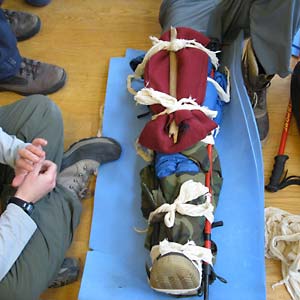
Learning to improvise a leg splint.
Imagine yourself kneeling next to a hiker who's slipped and broken a leg, or fallen and been knocked unconscious. What should you do?
If you're in a city, you'd probably call 911 and emergency medical services would arrive within 10 minutes. But if you're hiking on a trail or in a wilderness area without cell phone coverage, it may take hours or days for help to arrive. You might even have to hike out before you can call for help.
That's why knowing Wilderness First Aid (WFA, pronounced woofa) is so important. A victim's chances of survival are greatest if they receive care within a short period of time after a severe injury. For each quarter mile a victim is from a trailhead, it takes an additional 15 minutes for EMS to reach the scene. If your partner sustains a traumatic injury more than a mile or two from the road, you are their best chance for survival.
Wilderness First Aid teaches much more than how to bandage a blister or disinfect a cut, and many outdoor organizations require that camp counselors or trip leaders become certified before they can lead trips. Certification requires 16 hours of training, covering how to take control of an accident scene, assess a victim’s condition, and stabilize them. In addition, you learn how to splint broken bones, treat hypothermia and stop severe allergic reactions.
A Wilderness First Aid class is a surprisingly enjoyable experience, and taking it in a group setting is a lot of fun. In addition to lectures, you spend a lot of time in the field applying different techniques in staged scenarios. You’re taught how to improvise splints and cold injury treatments using gear and clothing that you have in your pack, as well as how to properly use the regular first aid supplies you bring with you when you go hiking.
Everybody should carry a basic first aid kit when they go hiking. But after you get your WFA certification, you’ll probably want to add a few extras like cloth cravats for making slings and splints, a large syringe for irrigating open wounds, and a pencil and notepad to keep track of vital signs.
For more information about Wilderness First Aid classes near you, contact NOLS Wilderness Medicine Institute, SOLO Wilderness Medicine School, or your local trail club.

 by Philip Werner
by Philip Werner









